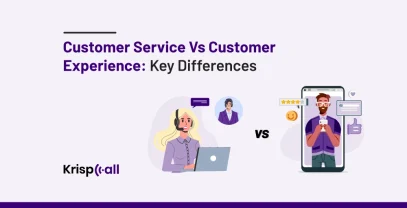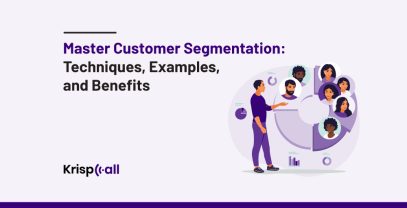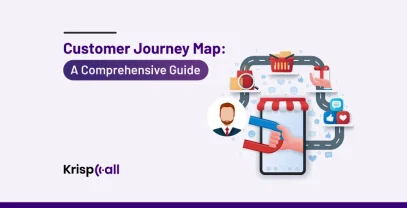Acquiring a new customer is undoubtedly more costly than maintaining those who have already done business with your brand.
A survey carried out in one study estimated that it is 4-5 times more costly to attract a new customer than not to do business with an existing customer. According to the Harvard Business Review, if your business increases its retention rate by just 5%, this may lead to an increase in revenue by 25% to 95%.
These statistics clearly show how important customer retention is. So, a business should mainly focus on it. But you might wonder how to calculate and improve your customer retention rate.
Don’t worry—this guide will walk you through the information needed to calculate and improve your business’s customer retention rate, and explore effective retention strategies.
🔑 KEY HIGHLIGHTS
- Customer retention rate measures the number of a firm’s loyal customers at a particular time, and it is always taken in percentages.
- The customer retention formula is as follows: [(Total customers at the period end — total customers acquired for the period)] / [Total customers at the beginning and end of the period] x 100.
- There are 4 fundamental ways to make customers more loyal: offering timely and quality service, offering quality products or services, creating a customer-specific customer environment, and giving customers special incentives or rewards.
- Essential metrics include churn rate, repeat purchase rate, customer service metrics, and customer lifetime value.
What is the Customer Retention Rate?
Customer retention rate is a measure business institutions use to determine how effectively they have retained customers for a certain period. It informs you of the percentage of customers who stick with you in the future and the likelihood that a customer will come again and transact again.

Many organizations regard this as among the most effective strategies in determining customer satisfaction with your firm. For example, if a business in the year begins with 10 customers and by the end of the year retains between 4 and 6, then the business retains 60% of customers for the year.
Nonetheless, as one will see, estimating customer retention rates is not as straightforward as one would expect. They also record important information on new customers you churn to get the right figures for your customer retention programs.
Customer retention rate formula
Customer retention rate is another commercial statistic that provides information about the percentage of customers that a firm continues serving in a given period of time. It’s calculated as:
Customer retention rate = (Number of customers at the beginning of the period minus the number of customers purchased in the period) / Number of customers at the end of the period x 100%.
In this formula:
- Number of Customers at the Start of Period: The number of customers at the start of the given period of time, whichever it may be, should be mentioned here.
- Number of Customers at the end of Period: The number of active customers using your business by the period’s close.
- Number of Customers Acquired During Period: The number of customers you added in that period. It is an important parameter, as it explains whether a company can attract new customers and expand the customer base during a given period.
Here, the total number of customers acquired in that period that did not start and were retained from the previous period can be determined by the difference between (total customers in the last period) and (new customers in the same period).
So, a company has started the period with 2500 customers, gains 400 new customers, and ends with 2350 customers, the customer retention rate is:
▶️ Customer Retention Rate=(2500−400/2350)×100=89.36%
This indicates that the company has retained its old clients at 89% in the stipulated time, which is a good customer retention rate.
How to calculate the customer retention rate?
Customer retention rate can be calculated by taking the total number of customers that a business started with within a given timeline, subtracting from it the remaining number of customers when that timeline ends, and adding the additional new customer gains during the time period.

It is, in fact, helpful rather than detrimental when all these new customers are thrown away. This way, we now have a deeper insight into which customers do not seem likely to remain with.
A CRR is calculated using the formula Customer retention rate (CRR) = (E-N)/S * 100, wherein:
- E = customer volumes during the period
- N = the total number of consumers gained over the specified period of time.
- S = number of customers present at the start of the period.
Let us consider its explanation using a business concept example. An ice cream seller starts with 30 customers in the first month. He can source 19 new customers for the month and ends the month with 37 customers.
The above formula gives CRR of 90% [CRR = ((37-10)/30)*100]
Retention Vs churn rate
Retention rate and churn rate are two sides of the same coin. Both measure customer behavior but from opposite perspectives. Retention rate is a positive metric as it shows how many customers stick around with your business over time. A high retention rate means people like what you offer and keep returning.

On the flip side, churn rate is a negative metric as it’s the percentage of customers who leave your business during that same time. While a low churn rate is ideal, it’s directly linked to a high retention rate. By focusing on strategies to improve customer satisfaction and reduce churn, you’ll naturally see a rise in customer retention rate, fostering a healthy and sustainable customer base.
How to calculate the customer churn rate?
The formula to calculate churn rate is: Number of customers lost during a period / Number of customers at the start of the period * 100.

The churn rate demonstrates the number of clients a company can lose over any particular time frame for using its services and products. A high churn rate is not a positive indicator because it’s costly for businesses to have an excess. A high level of churn rate means customers are unhappy and unsatisfied with your business.
Here’s a simplified explanation:
For example, let’s say a business starts with 100 customers at the beginning of the month and loses 30 customers by the end of the month. To calculate the customer retention rate, subtract the number of lost customers from the initial count (100 – 30 = 70). This gives you the number of customers retained. If the result is not in percentage form, you multiply by 100 to convert it. So, if 70 out of 100 customers are retained, the retention rate is 70%.
Churn Rate = (C / S) * 100, where Churn Rate is the churn rate percentage, C is the number of customers who churned, and S is the total number of customers.
Where:
In C, customers are eliminated during a certain period
S is the number of customers attributed to a particular point at the start of the period.
Percentage of dismissed workers = 30/100*100 = 30
What is a good customer retention rate?
A good customer retention rate can vary depending on your industry, business model, and customer lifecycle. However, some general benchmarks can provide a helpful starting point. Here’s a breakdown with relevant data:
- Generally acceptable range: According to Forbes, a 35% to 84% CRR is considered a good range across various industries. Some industries naturally boast higher retention rates.
- Top Performing Industries: Some industries naturally boast higher retention rates. For instance, Paddle cites the media and professional services sectors as leaders, with an average CRR of 84%. This might be due to long-term subscriptions or established client relationships.
- SaaS Benchmarks: For Software-as-a-Service (SaaS) companies, a 35% CRR over an eight-week period is considered a good starting point, according to UserVoice. This might be lower than other industries due to shorter subscription cycles or competitive alternatives.
However, it is always important to note your specific industry type and business goals and aims when determining your customer retention rate. For example, the retention level of a retail store would be lower as compared to a subscription service due to the type of product sold.
Other essential metrics for customer retention
Here are the essential metrics for customer retention:
Churn Rate
The churn rate can be directly concluded as the reverse of the customer retention rate. It captures the churn rate of clients transacting from one firm to another over a period. The churn rate must be as low as possible for the main reason that churn rate measures customer satisfaction and their level of commitment towards a product or service.
Repeat Purchase Rate
This is the number of customers likely to purchase the product from that company often. It refers to the percentage of customers that buy repeatedly from one firm. Customers repeat purchases because they have a positive experience and want to associate with such a firm again.
Customer Satisfaction Score (CSAT)
Customer satisfaction score (CSAT) is the ultimate measure of possibility that assesses whether customers are satisfied with the products or services that the company provides them. It’s a KPI that guides businesses in making data-based decisions, enhancing customer loyalty, and tracking satisfaction levels over time.
Customer Lifetime Value (CLV)
Customer lifetime value (CLV) is a projection of the total business in which an individual customer transacts with a company throughout their entire consumer life span. The compilation of customer value includes three key concepts: AOV, FOP, and CRM. The concept captures average order value through the total money spent by customers; purchase frequency quantified based on return time intervals to shop again or conversion, and a third variable pertaining to composing membership rate linked with shoppers who will buystrorekeepers› goods again dose.
How to improve customer retention rate?
Customer retention management can be the major approach to improving customer retention rates. Organizations can implement these major tips to avoid losing their customers:
1. Provide Excellent Customer service
Providing customers with the best experiences is among the most productive ways to increase customer loyalty rates. Ensure that your customer support service providers are knowledgeable, quick to offer support, and show concern for the customers.
It is also crucial to ensure that customers have options on how they can communicate with your organization, such as through a phone, email, or live chat.
2. Provide Your Consumers with Quality Goods or Services
As in any business venture, it is crucial for organizations to ensure that the products and services provided get close or go past the expectations set by the buyer. This implies that when focusing on preparing quality products, customers will be satisfied with the final product, thus satisfying them. From the view showcased, the probability of satisfaction improving if customers receive products or services fully or even beyond expectations is high.
3. Personalize the Customer Experience
One major goal in establishing and implementing personalized marketing strategies is to make customers feel that they are special in the business. Ensure that customer information is used wisely, for instance, in communication, suggestions, and promotional material that often reaches customers.
4. Implement a loyalty program
Provide rewards and incentives to customers through additional advantage or selling at a lower price than usual. It enhances customer loyalty and ensures customers keep attending to your company. This also fosters repeat business and customer patronage, thus helping create a loyal customer base.
5. Gather and Manage Feedback From The Customer
Customer retention rate can be increased by regularly engaging customers through surveys, reviews, and face-to-face interactions. Use this information to make decisions about possible growth, identify customer’s pain points, and enhance decision-making affecting the overall attribution of the customer’s journey. It is also the role of a company to make sure that the feedback received is responded to and to let the correspondent know that their feedback has been used.
Conclusion
While the strategy aims to attract new customers, it’s important not to overlook current ones. It is beneficial when customers remain attached to your company for quite some time because a low retention rate signifies the exact opposite.
There are various types of customer retention analysis to figure out why customers stick around or leave. Factors like exceptional customer service, quality products or services, positive customer experiences, and the implementation of a loyalty program should all be taken into account.
By evaluating customer retention and frequently improving on the scores, you will be in a better position to satisfy customers, increase your business’s revenue, and experience sustainable growth in the process.
FAQs
What formula is used to determine a company’s customer retention rate?
The formula used to determine a company’s customer retention rate is
Customer Retention Rate = (Total number of customers gathered at the end of the client obtaining period—total number of clients obtained in the current period).
Why is customer retention important?
Customer retention is important since many organizations’ profits are 5-10 times cheaper to acquire. It is a strong practice that brings benefits such as higher profit, longer customer lifetime value, and market dominance.
What are the major benefits of customer retention?
The major benefits of customer retention include:
- Increased revenue and profitability
- Lower customer acquisition costs
- customer satisfaction and positive word-of-mouth
- Increased sponsorship and advertising revenue
- The main factor of competitive advantage is that Being a market leader is always viewed as a strength as it helps a firm move further from its competitors.
What is the formula for customer retention in Excel?
The customer retention rate (CRR) can be calculated using a simple formula in Excel. Here’s how:
👍((B – C) / A) * 100
Where,
A = total customers at the beginning of the time period in question
B = Customer, at the period-end
C = Acquired customers during the period





